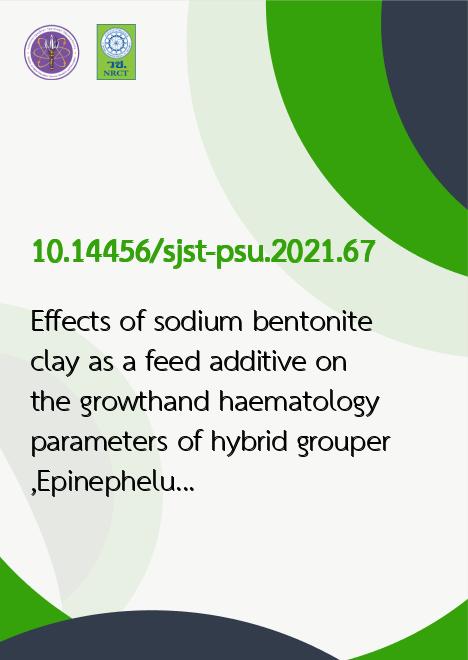
|
Effects of sodium bentonite clay as a feed additive on the growthand haematology parameters of hybrid grouper,Epinephelus fuscoguttatus x Epinephelus lanceolatus |
|---|---|
| รหัสดีโอไอ | |
| Creator | 1. Sazmal E. Arshad 2. Fatin Najiha M. Jeffrey 3. Zarina Amin 4. Rossita Shapawi |
| Title | Effects of sodium bentonite clay as a feed additive on the growthand haematology parameters of hybrid grouper,Epinephelus fuscoguttatus x Epinephelus lanceolatus |
| Publisher | Research and Development Office, Prince of Songkla University |
| Publication Year | 2564 |
| Journal Title | Songklanakarin Journal of Science and Technology (SJST) |
| Journal Vol. | 43 |
| Journal No. | 2 |
| Page no. | 505-511 |
| Keyword | sodium bentonite, growth, haematology, hybrid grouper |
| URL Website | https://rdo.psu.ac.th/sjstweb/index.php |
| ISSN | 0125-3395 |
| Abstract | This study evaluated the effects of inclusion levels of sodium bentonite clay as a feed additive on growth andhematology parameters of TGGG, Epinephelus fuscoguttatus ? E. lanceolatus. Four dietary treatments D1, D2, D3, and D4 feedscomprising 0, 1, 1.5, and 2% clay respectively were evaluated for weight gain (WG), specific growth rate (SGR), feed intake(FI), feed conversion ratio (FCR), survival, and hematology parameters. D3 comprising of 1.5% clay showed significantly higherWG, SGR, FI, red blood count (RBC), and the best FCR compared to the other dietary treatments. D4 comprising of 2% clayshowed the least desirable effects on growth performance and feed utilization of hybrid TGGG with significantly lower WG,SGR, and RBC compared to D3; as well as the poorest FCR value. D3 also showed the lowest WBC count compared to D1, D2and D4. Taken together, these findings indicated that dietary treatments comprising 1.5% clay is the most suitable among otherinvestigated treatments as a growth promoting feed additive. |
